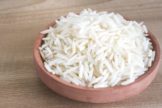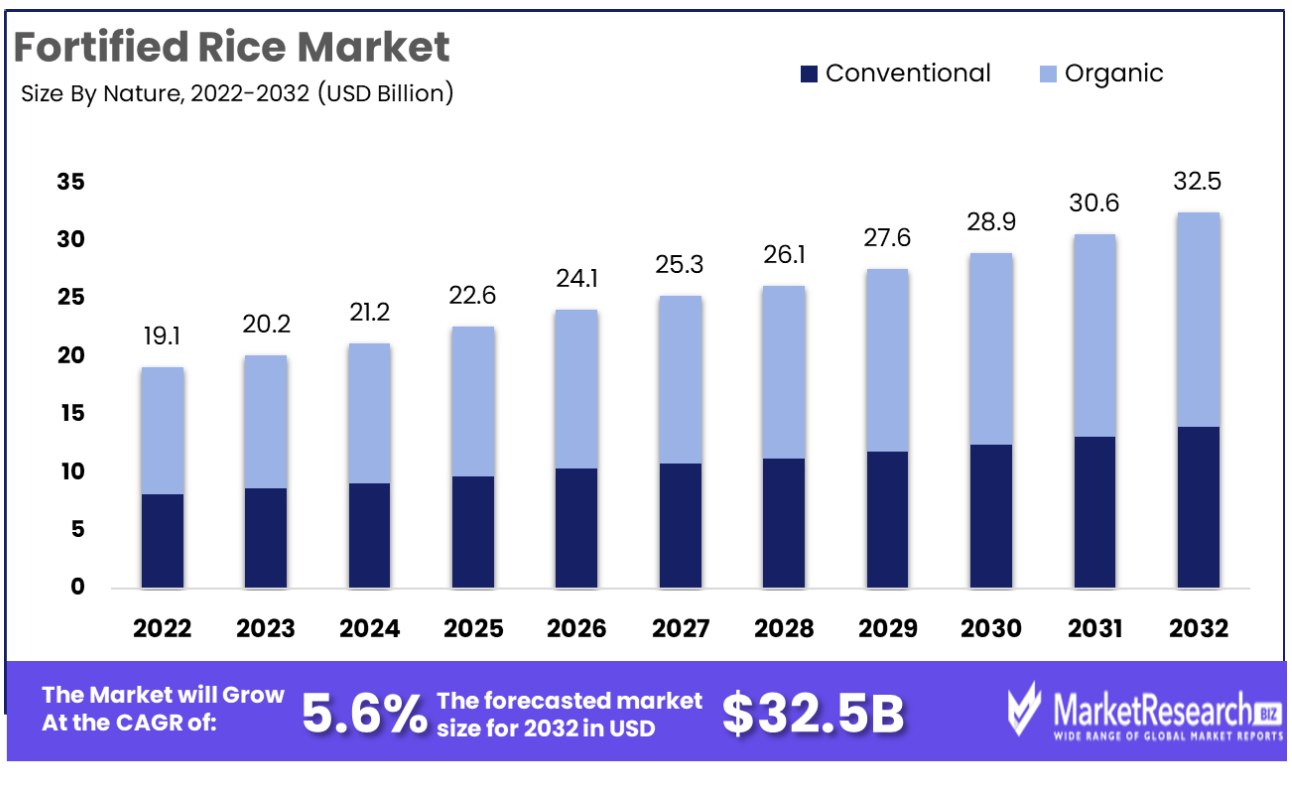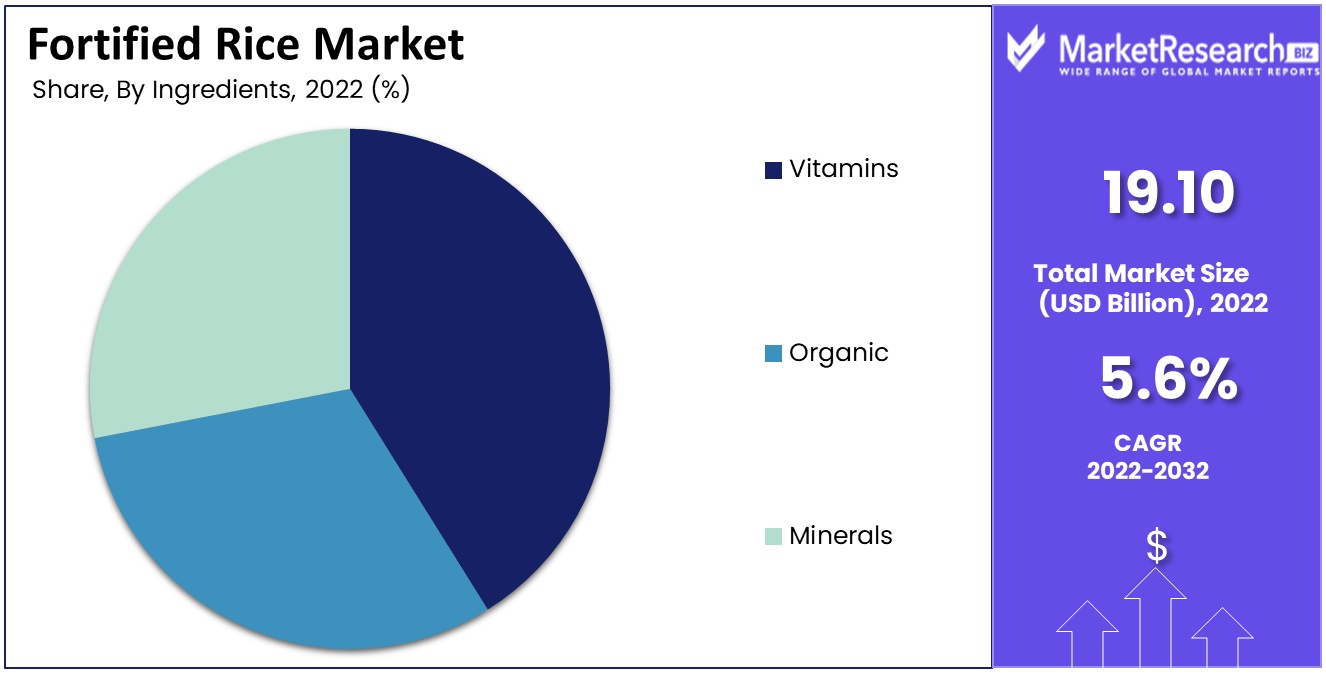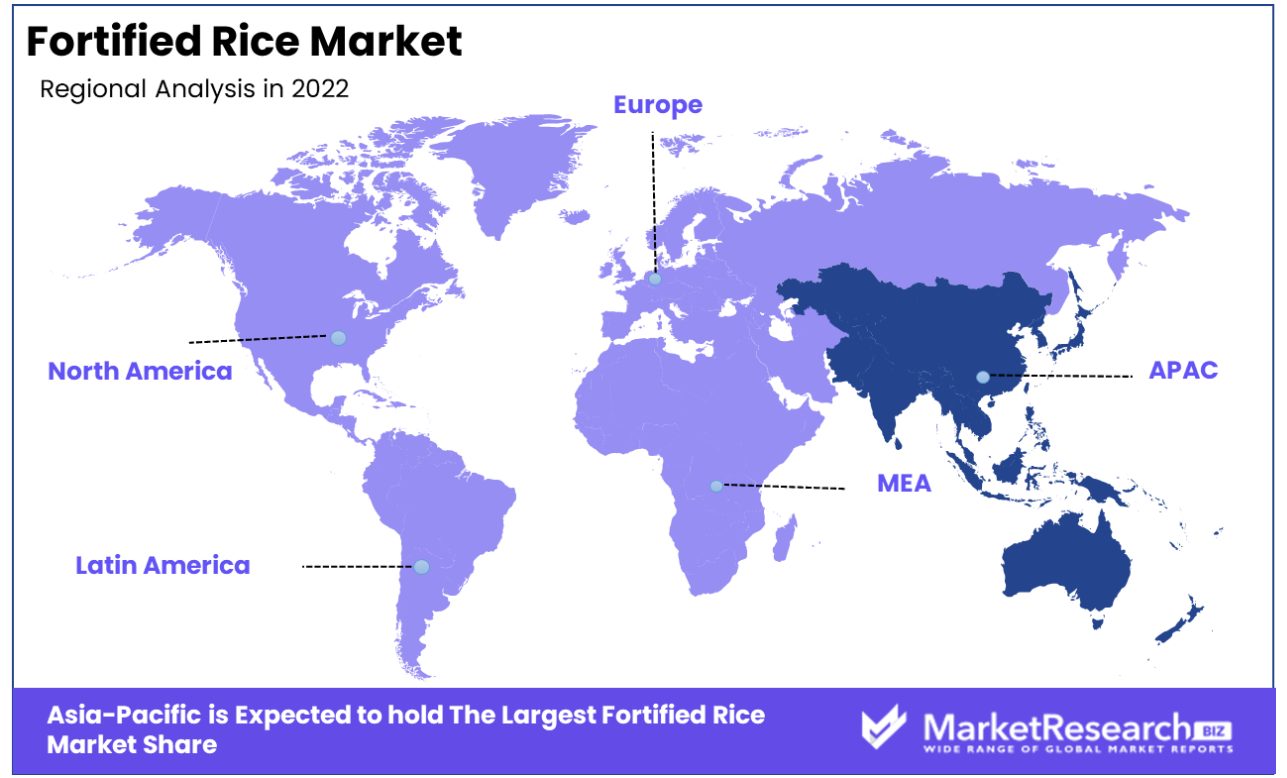
Fortified Rice Market By Nature(Conventional, Organic), By Distribution Channel(Offline, Online), By Ingredients(Vitamins, Organic), By Technology(Coating & Encapsulation, Drying, Others), By End User(Commercial, Residential), By Region And Companies - Industry Segment Outlook, Market Assessment, Competition Scenario, Trends, And Forecast 2023-2032
-
11781
-
May 2023
-
171
-
-
This report was compiled by Correspondence Linkedin | Detailed Market research Methodology Our methodology involves a mix of primary research, including interviews with leading mental health experts, and secondary research from reputable medical journals and databases. View Detailed Methodology Page
-
Fortified Rice Market Size, Share, Trends Analysis
The fortified rice market was valued at USD 19.10 billion in 2022. It is expected to reach USD 32.5 billion by 2032, with a projected CAGR of 5.6% during the forecast period from 2023 to 2032.
The surge in health consciousness among individuals and the rise in demand in the food and beverage industry are major driving factors for the rice fortification market. Globally, rice plays an important role in many diets.

More than 70% of individuals, especially from low-developing countries, are eating rice, indicating a significant dependency on rice. Though rice is a great source of energy, it is a poor source of micronutrients and there is an absence of nutritional value. This is reflected in the content of rice. It is due to the milling processing that generates white rice, such as tilda rice, eliminating the fat as well as the nutrient-rich bran layers.
Brown rice and bio-fortified rice like the high zinc rice are more nutritional as compared to white rice, affecting the overall rice quality. Bio-fortified rice is more nutritious because of the usage of different varieties of rice nutrients. Fortifying rice can help to decrease the nutrient gap by adding essential rice nutrients that are absent in the common rice. The fortification can be done without impacting the taste, appearance, or cooking procedures of the rice depending upon the technology that is used for fortifying the rice, influencing the rice market growth.
Consumers are becoming more conscious about their diet, with an increasing Consumption Of Rice. They are seeking nutritional food without much emphasis on taste. Many customers are inclined towards bio-fortified rice and brown grain as they are less in calories and provide more nutrition to the body, affecting the Rice Market Size.
Manufacturers like Hain Celestial are now focusing on fortified rice to meet the nutritional goals of end-use consumers. To do so, nutritional programs have to reach their full advantages as fortification programs are required to meet some specific needs to become more effective. Fortified grains are very convenient and easy to use, as rice is widely used as a common food, it is straightforward to change the preference from standard white rice to fortified to enhance the nutritional value in the daily diet, influencing the rice supply and tons of rice.
Moreover, advanced technologies are used for the fortification of the rice such as the use of hot extrusion, making sure to add high-quality micronutrients should remain steady without affecting the consumer’s requirement. Fortified can also be personalized for specific requirements like tuna rice, catering to the diverse needs in the market. It is the most preferred choice for individuals who are health conscious and are seeking new ways to reach specific health benefits, aligning with the Core Strategies of companies in this sector.
The demand for fortified rice will increase rapidly, as consumers opt for a good healthy diet. This will lead to a surge in market revenue and boost the growth of the fortified grain market during the forecast period.
Fortified Rice Market Dynamics
Growing Awareness of Micronutrient Deficiencies Drives Market Growth
The burgeoning consciousness of micronutrient inadequacies is a pivotal driver in the fortified rice market's expansion. This awareness stimulates consumer demand, particularly in regions grappling with nutritional deficits. The market responds by diversifying product offerings and integrating essential vitamins and minerals into grain, a staple food globally. This trend not only caters to health attentiveness among consumers but also aligns with public health initiatives, fostering partnerships between governments and manufacturers. The strategy outlook in this sector focuses on reducing healthcare costs and improving public health outcomes, reinforcing the fortified grain market's position as a solution to widespread nutritional challenges.
Rising Health Awareness Spurs Market Development
Elevated health attentiveness among consumers is fundamentally reshaping the fortified grains industry. This shift goes beyond addressing micronutrient deficiencies; it encompasses a broader pursuit of wellness through diet. The market is adapting with a channel strategy that introduces products with enhanced health benefits, appealing to a more informed and health-centric customer base. This awareness is increasingly influencing purchasing decisions, driving demand for nutritionally enriched grain. The synergy of consumer health trends with advancements in food technology, as indicated by forecast analysis, suggests a sustained growth trajectory, positioning fortified as a key player in the health-focused food sector.
Increasing Investments in Research and Development Catalyze Market Evolution
Heightened investments in research and development (R&D) are crucial in propelling the fortified grain market forward. These investments, part of the industry's key strategies, enable the development of more efficient fortification techniques and the discovery of new nutrient combinations, catering to diverse dietary needs and preferences. This R&D push, aligned with cost-effective complementary strategies, not only enhances product quality but also broadens the market reach by addressing specific health concerns and regional dietary requirements. The collaboration between R&D and marketing strategies is set to foster innovation, potentially leading to the emergence of novel products and fortification methods.
Expansion of End-Use Industries Accelerates Market Growth
The growth of end-use industries, such as food processing and hospitality, significantly amplifies the fortified rice market's expansion. These industries increasingly incorporate fortified rice into their offerings, driven by the rising demand for healthier food options. This expansion aligns with global trends toward nutritious and convenient food products, making fortified grain an attractive ingredient for various applications. The intersection of these expanding industries with consumer health trends creates a robust demand for fortified grain, promising sustained market growth. The long-term effect could be a more integrated approach in the food industry, where health, convenience, and taste converge, further solidifying the market's growth trajectory.
High Cost of Technology Restrains Market Growth
The technology required for rice fortification involves both initial capital investment and ongoing operational expenses, making it a significant barrier for many potential market entrants. This high cost primarily stems from the need for advanced machinery to embed nutrients without compromising rice quality. Additionally, maintaining consistent nutrient levels requires sophisticated quality control mechanisms, further elevating costs. As a result, smaller producers often find it challenging to compete, leading to a concentration of the market in the hands of a few well-capitalized players. This limitation not only restricts market diversity but also impacts the geographical reach of fortified cereal especially in regions where investment capital is scarce.
Lack of Awareness Restrains Market Growth
Awareness regarding the health benefits of fortified sushi remains surprisingly limited, particularly in regions that would benefit most from its nutritional enhancements. The lack of awareness is partly due to insufficient educational campaigns and the absence of a robust marketing push from industry players. This gap in understanding extends to both consumers, who are often unaware of the benefits of fortified over traditional varieties, and to potential investors who might otherwise see the market’s potential. The consequence is a slower adoption rate of fortified cereal, hindering market growth. Elevating awareness through targeted educational and marketing initiatives could significantly catalyze market expansion.
Fortified Rice Market Segmentation Analysis
By Nature Analysis
The conventional segment of the fortified rice market is preeminent, driven by its accessibility and cost-effectiveness. This segment leverages economies of scale, ensuring widespread availability in various markets, including products like Black Rice. The conventional processing methods cater to a broad consumer base, encompassing both developed and emerging markets. Current trends indicate a robust demand in regions with high rice consumption and nutritional deficiencies, often lacking in vital micronutrients. However, this segment faces challenges, such as consumer shifts towards healthier, organic options, and regulatory scrutiny regarding additives.
While the organic segment is smaller, it's growing rapidly, propelled by increasing health consciousness and environmental concerns. This segment, though premium-priced, is gaining traction in affluent markets where consumers are willing to pay more for perceived health and quality benefits, including the micronutrient (minerals, vitamins) content. The growth of organic fortified rice is particularly notable in North America and Europe, where organic food consumption is on the rise. This segment, albeit smaller, complements the conventional segment by catering to a niche but growing market, emphasizing the basis of micronutrient enhancement.
By Distribution Channel Analysis
Offline channels dominate the distribution of fortified rice, largely due to consumer habits and the tactile nature of food shopping. Supermarkets and convenience stores offer the advantage of physical product inspection and immediate purchase, which is a significant driver for this segment, especially for products enriched with micronutrients (minerals, vitamins). These channels also benefit from established supply chains and the ability to offer a wide range of products, enhancing consumer choice. The trend toward supermarket private labels offering fortified rice products is also notable, further bolstering this segment's dominance.
The online segment, though smaller, is witnessing accelerated growth, especially post-pandemic. The convenience of home delivery, the rising penetration of e-commerce in food retail, and the ability to reach remote areas are pivotal factors fueling this growth. Online platforms are also becoming key for niche products, such as organic fortified rice, where physical retail presence is limited. This segment's growth is indicative of a broader digital transformation in consumer shopping behaviors.
By Ingredients Analysis
Vitamins constitute the majority share in the fortified rice market. This dominance is attributed to the widespread prevalence of vitamin deficiencies globally and the critical role of vitamins in addressing these, underlining the importance of vital micronutrients. Vitamin A and B-complex, in particular, are commonly used in fortification due to their essential health benefits. This segment's growth is fueled by governmental initiatives in regions with high malnutrition rates and the increasing awareness of micronutrient deficiencies.
The mineral fortification segment, while smaller, plays a vital role in addressing specific nutritional deficiencies like iron and zinc. This segment is particularly significant in regions with specific dietary gaps, emphasizing the basis of micronutrients. The growth in this segment is driven by targeted nutrition programs and increasing consumer awareness about the importance of minerals in the diet.

By Technology Analysis
Coating and encapsulation technologies are pivotal in the fortified rice market, ensuring nutrient stability and effective delivery of vital micronutrients. These technologies are preferred for their efficiency in maintaining nutrient integrity during cooking and storage. The dominance of this segment is also due to the technological advancements that have made these methods more cost-effective and scalable.
While less dominant, these technologies are significant for specific applications and market needs. Drying and extrusion are particularly relevant in cost-sensitive markets, offering alternative methods of fortification. The 'Others' category, encompassing techniques like dusting, plays a niche but important role in fortification where other methods may not be viable.
By End User Analysis
The commercial segment, encompassing hotels, restaurants, and institutional settings, is a major consumer of fortified rice. This dominance is fueled by the large-scale procurement practices of these entities and the rising demand for nutritious, ready-to-eat meals. Additionally, government contracts for fortified rice in school feeding programs and disaster relief significantly contribute to this segment's size.
The residential segment, while smaller, is growing due to increasing health awareness and the availability of fortified rice in consumer-friendly packaging. The trend towards health-conscious eating at home is a key driver for this segment, especially in urban areas where lifestyle diseases are prevalent, and awareness of the importance of micronutrients (minerals, vitamins) is increasing.
Fortified Rice Industry Segments
By Nature
- Conventional
- Organic
By Distribution Channel
- Offline (Supermarkets, Convenience stores, Brick-and-Mortar)
- Online
By Ingredients
- Vitamins
- Organic
- Minerals
By Technology
- Coating & Encapsulation
- Drying
- Extrusion
- Others
By End User
- Commercial
- Residential
Growth Opportunity of the Fortified Rice Market
Product Innovation Offers Growth Opportunity
Product innovation acts as a catalyst for expansion in the Fortified Rice Market Report. The development of new formulations and processing technologies not only enhances the nutrient profile of rice but also improves its appeal to health-conscious consumers, emphasizing personal health. Recent trends show a growing demand for nutritionally enhanced foods, a segment where rice, as a staple food, plays a key role. Innovations like the incorporation of micronutrients that withstand cooking processes have marked a significant advancement in the rice market's competitive landscape. This drive for innovation, often supported by scientific research, paves the way for market growth by attracting a wider consumer base seeking healthier dietary options for their health benefits.
Private Sector Investment Drives Market Growth
The influx of private sector investment is a substantial driver of growth in the fortified rice market. Financial backing from private entities has enabled significant advancements in production capabilities and supply chain efficiency, reflecting an increased focus on environmental health. The recent trend of increased investment in food technology and nutrition-focused startups underlines this point. These investments allow for scaling up production, enhancing quality control, and expanding market reach. Private capital also fosters collaborations between companies and research institutions, leading to innovations in fortification technology and new product development, thereby broadening the market scope and consumer appeal.
Multiple Fortified Rice Options Fuel Market Expansion
The availability of multiple fortified rice options is pivotal in fueling market expansion, catering to various consumer preferences and personal health requirements, thereby broadening the market base. Recent trends indicate an increasing consumer inclination towards personalized nutrition, which these options accommodate. For instance, rice fortified with specific vitamins and minerals for different demographic groups (like children or the elderly) addresses distinct nutritional needs. This variety not only meets the growing demand for tailored nutrition but also enhances consumer engagement and loyalty, reflecting the evolving rice market competitive landscape.
Fortified Rice Market Regional Analysis
Asia Pacific Dominates with Majority Market Share
In the fortified rice market, Asia Pacific's dominance is underpinned by a variety of factors. Primary among these is the region's intrinsic cultural attachment to sushi as a staple food, which ensures a consistent, high-volume demand. This demand is further bolstered by growing health consciousness among consumers, who are increasingly seeking nutrient-enriched food options. Additionally, the robust agricultural infrastructure in countries like India and China facilitates large-scale production of fortified grain.
Looking ahead, Asia Pacific's influence in the fortified market is poised to grow. The region's expanding middle class, with increasing disposable income, is likely to further boost demand for nutrient-rich food products. Additionally, ongoing government initiatives aimed at nutrition improvement are likely to continue, potentially leading to new policies that further encourage fortified rice consumption. These factors, combined with the region's robust production capabilities, suggest a sustained, if not strengthened, market presence for Asia Pacific in the coming years.

Europe
Europe's fortified rice market, though not as extensive as Asia Pacific's, is demonstrating notable growth. The region's increasing focus on health and wellness, coupled with a rising immigrant population accustomed to rice-based diets, is driving demand. European consumers are showing a growing preference for nutritionally enhanced foods, including fortified grains, as part of a balanced diet. The market is also benefiting from stringent food safety regulations, which ensure high product quality. This focus on quality, along with an evolving consumer base, positions Europe as an emerging player with the potential for significant market expansion.
North America
In North America, the fortified rice market is characterized by its emphasis on innovation and specialized products. The region's consumers, with their diverse dietary preferences and health-conscious attitudes, are increasingly opting for fortified grains as a nutritious alternative to traditional staples. The market is also witnessing a trend towards organic and non-GMO fortified sushi products, catering to a niche but growing segment. Technological advancements in fortification and a strong distribution network further bolster the region's market presence. North America's focus on quality and niche markets is set to keep it an important player in the global fortified rice landscape.
Fortified Rice Market By Region
North America
- The US
- Canada
- Rest of North America
Europe
- Germany
- France
- The UK
- Spain
- Italy
- Russia
- Netherlands
- Rest of Europe
Asia-Pacific
- China
- Japan
- South Korea
- India
- New Zealand
- Singapore
- Thailand
- Vietnam
- Rest of Asia Pacific
Latin America
- Brazil
- Mexico
- Rest of Latin America
Middle East & Africa
- South Africa
- Saudi Arabia
- UAE
- Rest of Middle East & Africa
Fortified Rice Market Key Player Analysis
In the dynamic landscape of the fortified rice market, key players are in distinct niches, leveraging unique strengths to influence this burgeoning sector. Cargill Incorporated and Bunge Limited, renowned for their agricultural commodity prowess, have strategically positioned themselves as vital players, ensuring supply chain robustness and raw material excellence. These companies underscore the market's reliance on efficient logistics and quality inputs. Bühler AG's technological innovation in rice fortification processes sets them apart, underscoring the importance of R&D in this sector.
BASF SE and Koninklijke DSM N.V., with their expertise in nutritional additives, have become pivotal in enhancing the value proposition of fortified grains, aligning closely with global health and nutritional goals. Their focus on micronutrient enrichment reflects the market's shift towards health-centric offerings. General Mills, Inc., known for its consumer-centric approach, and Wilmar International Ltd., with its extensive Asian market presence, have adeptly navigated consumer preferences, shaping market trends and demand dynamics.
Kohinoor Specialty Foods India Private Ltd., by focusing on regional tastes and dietary needs, highlights the market's geographical nuances and the importance of localized strategies. Collectively, these key players not only drive the fortified grains market's growth but also underscore the significance of innovation, strategic supply chain management, and alignment with global health objectives in shaping the market
Fortified Rice Industry Key Players
- Cargill Incorporated
- Bunge Limited
- Bühler AG
- BASF SE
- General Mills, Inc.
- Koninklijke DSM N.V.
- Wilmar International Ltd.
- Kohinoor Specialty Foods India Private Ltd.
- KRBL Limited
- REI Agro Ltd.
- Freedom Foods Group Limited
- LT Foods
Recent Development
- In October 2023, The Pilot Production of Fortified Rice in Nigeria was launched through a collaboration between the Global Alliance for Improved Nutrition (GAIN), the United Nations World Food Programme (WFP), the Federal Ministry of Health, and the Kebbi State Government. This marked a significant milestone in the efforts to combat malnutrition in Nigeria, particularly in addressing micronutrient deficiencies.
- In October 2023, Guyana became the first country in the Latin America and Caribbean region (LAC) to cultivate a bio-fortified rice variety known as GRDB IICA 17. This variety, designated as G18-113, contains 17 to 20mg of zinc per kilogram.
- In February 2022, Jesica Kincaid, Senior Manager of International Trade Policy at USA, highlighted the importance of staple food for over 3.5 billion people worldwide. She also emphasized the role of the United States in grain production and its contribution to global food security.
- In May 2022, Scoping of fortified and nutritious food products for targeted households and strengthening the distribution network to the last mile was commissioned by Joint Action for Nutrition Outcome (JANO), CARE Bangladesh, and conducted by icddr,b.
Report Scope
Report Features Description Market Value (2022) USD 19.10 Billion Forecast Revenue (2032) USD 32.5 Billion CAGR (2023-2032) 5.6% Base Year for Estimation 2022 Historic Period 2016-2022 Forecast Period 2023-2032 Report Coverage Revenue Forecast, Market Dynamics, COVID-19 Impact, Competitive Landscape, Recent Developments Segments Covered By Nature(Conventional, Organic), By Distribution Channel(Offline, Online), By Ingredients(Vitamins, Organic, Minerals), By Technology(Coating & Encapsulation, Drying, Extrusion, Others), By End User(Commercial, Residential) Regional Analysis North America - The US, Canada, Rest of North America, Europe - Germany, France, The UK, Spain, Italy, Russia, Netherlands, Rest of Europe, Asia-Pacific - China, Japan, South Korea, India, New Zealand, Singapore, Thailand, Vietnam, Rest of Asia Pacific, Latin America - Brazil, Mexico, Rest of Latin America, Middle East & Africa - South Africa, Saudi Arabia, UAE, Rest of Middle East & Africa Competitive Landscape Cargill Incorporated, Bunge Limited, Bühler AG, BASF SE, General Mills, Inc., Koninklijke DSM N.V., Wilmar International Ltd., Kohinoor Specialty Foods India Private Ltd., KRBL Limited, REI Agro Ltd., Freedom Foods Group Limited, LT Foods Customization Scope Customization for segments, region/country-level will be provided. Moreover, additional customization can be done based on the requirements. Purchase Options We have three licenses to opt for Single User License, Multi-User License (Up to 5 Users), Corporate Use License (Unlimited User and Printable PDF) -
-
- Cargill Incorporated
- Bunge Limited
- Bühler AG
- BASF SE
- General Mills, Inc.
- Koninklijke DSM N.V.
- Wilmar International Ltd.
- Kohinoor Specialty Foods India Private Ltd.
- KRBL Limited
- REI Agro Ltd.
- Freedom Foods Group Limited
- LT Foods




